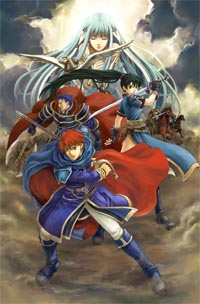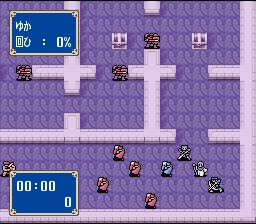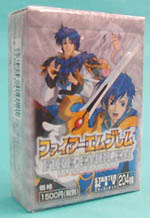
Introduction
Part 1: Intelligent Systems
Part 2: Dark Dragon and Sword of Light
Part 3: Fire Emblem Gaiden
Part 4: Mystery of the Emblem
Part 5: Genealogy of the Holy War
Part 6: Thracia 776
Part 7: Sword of Seals
Part 8: Blazing Sword
Part 9: Fire Emblem Tradition
Part 10: BS, The Anime, The Card Game, and the Future
Originally written for
in January 2004
by Derek Miller

 In March of 1995 the Bandai Satellaview, or BS-X, was released for Super Famicom. The system was designed to use the Japanese satellite system St. GIGA to allow the owner to download game updates, news, tips, demos and more. The problem with the system, and the reason it never took off, was you could only download games during their broadcast dates, and only from 4 to 7 pm. This was because the St. GIGA system broadcast television shows the rest of the time, and didn't have the capability to provide downloadable content as well as television programming. You downloaded games to 1 Megabit cartridges called BS-X Special Broadcast Cassettes. The best part of the system was that everything was free, but the only two companies to provide content were Nintendo and Square. Nintendo released some cool content including an update to F-Zero with new vehicles and a new league, a remake of the original Legend of Zelda with updated graphics, Mario Excitebike that was an update to the NES classic that included Mario characters, and much more. Square released numerous game demos for the Satellaview including Chrono Trigger and Radical Dreamers demos.
In March of 1995 the Bandai Satellaview, or BS-X, was released for Super Famicom. The system was designed to use the Japanese satellite system St. GIGA to allow the owner to download game updates, news, tips, demos and more. The problem with the system, and the reason it never took off, was you could only download games during their broadcast dates, and only from 4 to 7 pm. This was because the St. GIGA system broadcast television shows the rest of the time, and didn't have the capability to provide downloadable content as well as television programming. You downloaded games to 1 Megabit cartridges called BS-X Special Broadcast Cassettes. The best part of the system was that everything was free, but the only two companies to provide content were Nintendo and Square. Nintendo released some cool content including an update to F-Zero with new vehicles and a new league, a remake of the original Legend of Zelda with updated graphics, Mario Excitebike that was an update to the NES classic that included Mario characters, and much more. Square released numerous game demos for the Satellaview including Chrono Trigger and Radical Dreamers demos.
 In October of 1997 Nintendo released four episodes of a Fire Emblem series known as Akaneia Senki Hen Dai. The four episodes were not full games in the tradition of the rest of the series. Each episode contained only one map with no battle animations, and little story. They were all side-stories of Mystery of the Emblem, but you were simply thrown into an extremely difficult situation and were forced to use your strategic skills to fight your way through. The first episode gave you only six characters, and you had to retake a castle overflowing with enemies. The second episode pit you against an army of archers when you had an army consisting mostly of aerial units. Episode three features a castle that has been overrun by thieves and armored knights. You needed to protect the castle's treasure from the thieves while fending off the knights and reinforcements. The final episode gave you a small army of men that you must use to defend against an opponent that gained ten reinforcements every turn. Every episode was timed, and you needed to complete it in the required time in order to win. The BS games featured mostly new characters, but did include a few characters from Mystery of the Emblem with new artwork. These games were not meant to be full-fledged games, and only served as great challenges for fans of strategy/RPGs. These episodes were rebroadcast in December of 1997 and April of 1999, but since the St. GIGA system was closed there is no way to get these games except buying them from someone who downloaded them while they were broadcast.
In October of 1997 Nintendo released four episodes of a Fire Emblem series known as Akaneia Senki Hen Dai. The four episodes were not full games in the tradition of the rest of the series. Each episode contained only one map with no battle animations, and little story. They were all side-stories of Mystery of the Emblem, but you were simply thrown into an extremely difficult situation and were forced to use your strategic skills to fight your way through. The first episode gave you only six characters, and you had to retake a castle overflowing with enemies. The second episode pit you against an army of archers when you had an army consisting mostly of aerial units. Episode three features a castle that has been overrun by thieves and armored knights. You needed to protect the castle's treasure from the thieves while fending off the knights and reinforcements. The final episode gave you a small army of men that you must use to defend against an opponent that gained ten reinforcements every turn. Every episode was timed, and you needed to complete it in the required time in order to win. The BS games featured mostly new characters, but did include a few characters from Mystery of the Emblem with new artwork. These games were not meant to be full-fledged games, and only served as great challenges for fans of strategy/RPGs. These episodes were rebroadcast in December of 1997 and April of 1999, but since the St. GIGA system was closed there is no way to get these games except buying them from someone who downloaded them while they were broadcast.
 In 1996 Nintendo decided to try to bank on the popularity of the Fire Emblem plot by creating an anime based on the original game. The anime featured two pilot episodes that began the story that was told in the original Fire Emblem, but they also included a great number of flashbacks that told more about Marth's history that was not told in the game. However, the flashbacks seemed out of place in the anime, and made it very confusing. Only the most devoted fans of the Fire Emblem series were interested in this anime series, and it was not continued after the first two pilot episodes. Strangely enough, the two episodes were actually released on VHS in the United States with English subtitles. This is sort of odd since the U.S. had no exposure to the Fire Emblem series, and most would have no interest in an anime based on a Japanese-only series. Another oddity was Marth was called Prince Mars in the subtitles of the English version. Some hardcore Fire Emblem fans actually prefer this name for him, but for most new Fire Emblem fans this is a little strange.
In 1996 Nintendo decided to try to bank on the popularity of the Fire Emblem plot by creating an anime based on the original game. The anime featured two pilot episodes that began the story that was told in the original Fire Emblem, but they also included a great number of flashbacks that told more about Marth's history that was not told in the game. However, the flashbacks seemed out of place in the anime, and made it very confusing. Only the most devoted fans of the Fire Emblem series were interested in this anime series, and it was not continued after the first two pilot episodes. Strangely enough, the two episodes were actually released on VHS in the United States with English subtitles. This is sort of odd since the U.S. had no exposure to the Fire Emblem series, and most would have no interest in an anime based on a Japanese-only series. Another oddity was Marth was called Prince Mars in the subtitles of the English version. Some hardcore Fire Emblem fans actually prefer this name for him, but for most new Fire Emblem fans this is a little strange.
 Since the anime was released there has been tons of Fire Emblem merchandise released in Japan. Artbooks, manga, music CDs, and even a trading card game have been produced in Japan, and most of it is even available for purchase online. The trading card game is the most recent addition to the Fire Emblem family of merchandise as it was just released in 2002. The trading card game features unit cards and weapon cards. It is tough to understand how to play the game without knowing Japanese, but it in essence has you creating an army by combining unit cards with weapon cards and battling your opponent. The card game began in 2002 with cards featuring units and weapons from Genealogy of the Holy War, and it is now focusing on Mystery of the Emblem cards.
Since the anime was released there has been tons of Fire Emblem merchandise released in Japan. Artbooks, manga, music CDs, and even a trading card game have been produced in Japan, and most of it is even available for purchase online. The trading card game is the most recent addition to the Fire Emblem family of merchandise as it was just released in 2002. The trading card game features unit cards and weapon cards. It is tough to understand how to play the game without knowing Japanese, but it in essence has you creating an army by combining unit cards with weapon cards and battling your opponent. The card game began in 2002 with cards featuring units and weapons from Genealogy of the Holy War, and it is now focusing on Mystery of the Emblem cards.
 When this feature was originally written there were a number of rumors regarding the future of Fire Emblem. There were some strong rumors that Sword of the Seals would be translated for English markets as well as rumors of a GameCube Fire Emblem. While Sword of the Seals has not been translated for other markets, yet, we received great news from Nintendo when they announced new Fire Emblem games for GameCube as well as Game Boy Advance. Sales of over 200,000 copies of Blazing Sword in the U.S. must have convinced Nintendo that the series was fit for the U.S. 200,000 in sales for a relatively unknown series is pretty good for Game Boy Advance. The Game Boy Advance game has already been released as Fire Emblem: The Sacred Stones in the U.S., and the GameCube game is set to be released in late 2005, and it seems the Fire Emblem series is here to stay.
When this feature was originally written there were a number of rumors regarding the future of Fire Emblem. There were some strong rumors that Sword of the Seals would be translated for English markets as well as rumors of a GameCube Fire Emblem. While Sword of the Seals has not been translated for other markets, yet, we received great news from Nintendo when they announced new Fire Emblem games for GameCube as well as Game Boy Advance. Sales of over 200,000 copies of Blazing Sword in the U.S. must have convinced Nintendo that the series was fit for the U.S. 200,000 in sales for a relatively unknown series is pretty good for Game Boy Advance. The Game Boy Advance game has already been released as Fire Emblem: The Sacred Stones in the U.S., and the GameCube game is set to be released in late 2005, and it seems the Fire Emblem series is here to stay.